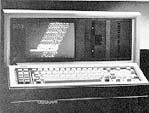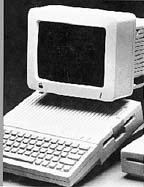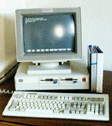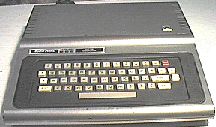Tumbleweeds Personal Collection

Tumbleweed's Personal Collection

About 17 years ago my father brought home a TRS80 Color Computer which hooked up to the back of the TV. With cartridges and joysticks my brothers and I played many popular games while my father tried to figure out how the accounting software was supposed to work. I used that computer to teach myself BASIC a couple of years before my classmates and I would find that the high school had a room of Apple IIe's for us to learn on. It's been love ever since.
About 12 years ago I was the proud owner of an IBM XT. I got it from a friend of mine who was a PhD candidate at Brown who had received a newer free computer from his grant program. It was the first computer in my apartment. I used it to write college papers, manage a schedule and play simple games. It was around then that I fell for Sierra On-line's Space Quest. I picked up some more BASIC programming, but mostly it was used for writing.
At the Rhode Island College Writing Center we picked up a similar computer for records keeping and word processing, and we hosted a small AT&T mainframe computer with Writers Workbench software. Even as I spent my years studying English Lit, I has already made computers a daily part of my life.
Around 1990 my father came through again and sold me (very cheaply I might add) his old Tandy TL/2 1000. Better then the XTs at college I added a modem and soundcard and was all set! I then spent the following years wandering Rhode Island's bulletin board community and from there, the occaisional long distance call to a BBS in California or Texas as a foray into the national electronic community. Remember, this was all before the Internet left the hallowed halls of the university system or the defense community.
I've come to love each and every machine.
Eventually the disk drive on the Tandy died and refused to be ressurected. I had a Mac LCII which worked all right except for a non-working floppy disk drive and a corrupt system. It didn't boot, it gathered dust. What was I to do? It was the only computer in the house!
A sympathetic friend came over and lent me a VT100 terminal and 1200 baud modem. I was back on-line. Granted, there were no flashy graphics. No disk drive to download or save files to. But I was still connected to the electronic community. I could connect to USENET and run Lynx over a modem hookup to the Ocean State Free-net.
That was around when I decided to start collecting older computers. My nostalgic fondness for the machines of my past merged well with my new acquisitiveness and the sudden availability of all these older, classic machines from various individual's closets, garages and so forth.
Below is a list of my collection. I have pretty much stopped adding to my personal collection in favor of acquiring more micros for the Retro-Computing Society of Rhode Island. But I still keep an eye peeled for certain systems. Check out my Wish List page to see what I'm looking for!
Now, in no particular order... Enjoy!

List of computers

- IBM PC XT
- Typical of the grey boxes so prominent during the eighties. 256K CGA machine w/ two disk drives, serial printer port and 4 color monitor. The first monitor was actually a mono-green. Eventually I found an amber as well just for variety. This computer got used primarily for BASIC programming, games, school papers and the odd letter. For a while after receiving it, software was still available in stores such as Egghead Software, then after that I had to go to computer fairs and search the "classic programs" bins. Now it's simply a battle to preserve the disks I still have. Still, many shareware sites still exist as well as ftp archives that have programs suauable on these. Simple comm programs make it still useful as a text-only terminal and I can still hook a printer up to it if I want to write with it papers again.

- Tandy TL/2 1000
- This is actually a very interesting piece of work. It was one of the last 286 models made by Tandy that ran their own version of DOS that was mostly, but not 100 percent compatible with "standard" MS-DOS. Its 16-color graphics (TGA) was not compatible with the more popular EGA. Still, many game programs included TGA in their compatibility design. The Tandy TL/2 1000 also came with its own desktop program called Deskmate that could run in either tree mode or in a desktop mode with programmable buttons. It made configuring very easy and pleasant. The writing, drawing, and accounting software was well thought out, but not very cross-compatible. The Tandy also had a three-voice speaker that could produce excellent sound quality. A soundblaster card only enhanced my enjoyment. The original Tandy I bought from my father is a memory now, but I found another to take its place on the kitchen table. This came with a 3.5 inch drive and a 20mb HD. It was not upgradeable w/o replacing the entire motherboard.
Recently I've found some early Japanese word processing software that runs on it. This was all from before the DOSV standard, but it prints out well in bitmat and can be used to read JIS formated files off the net.
- Macintosh LCII
- Presently my "workhorse" computer only because itıs hooked up to the 14.4 modem. It came with 4MB of RAM now "upgraded" to 8. The floppy disk drive is still inoperable but a Zip disk drive takes care of most of my needs as well as an Appletalk link to the Classic. While designed for system 6, I'm running 7.5.1 without many problems, and I'm not the only one! Two other people I've met are running a virtually identical setup and use theirs to edit and organize articles for magazines. I've also managed to add Japanese language capability with the Japanese Language Kit.
The LCII was not a well thought out design because while it has the capability to run 32 bit software and virtual memory, it has 16 bit architecture and is fairly slow compared to the more muscle machines I have at work (Yes, they're PowerPCs!) Still, it's an accesible machine that still handles most of my graphic-oriented work.
- Macintosh Classic
- Even older than the LCII, the Classic has a built in mono-monitor and 4mb of RAM. (I've managed to coax it into running JLK under system 7.5.1 as well!) The disk drive on this works so I often use this as a transfer computer between the working disk drive and the Zip disk drive for the LCII.
- VT131 Terminal
- This was what saved me from madness when I was computer-less. The ultimate in simple and graceful access. I dialed directly into the host and let the terminal tell the host what to do. Granted, there was no storage device available but you would be surprised how little that concerns you after awhile. I think it was a "being there" kind of thing. However, a terminal like this can be hooked up directly to another host computer just as easily as through a modem. If you look at the PDP-12's on the millspace page, you will note that a very similar terminal is calling the shots there.

- Compaq Plus
- "Portable" IBM XT style computer in that it contracts into a suitcase-like state for easy portability, but about 50 lbs! I once carried one of these for a mile and a half to a former boss's house so she could work over the weekend. Not again! ^_^ Still, this one only cost me about 15 dollars at a flea market, untested. Came with a 10mb HD and 5.25 floppy drive. The built in monochrome monitor could handle the CGA graphics capability but because the monitor was built into the casing, it was sometimes difficult to focus in on the screen. This model came with a built in modem (removed on mine) and had a serial printer port. Presently mine is having some disk drive woes, but otherwise boots fine off of DOS 3.0.
- WANG XT
- Wang's version of the IBM PC XT. This was originally hooked up to a larger mainframe belonging to the Navy. The mainframe connection software is still present and useable, unless you try to connect to the missing mainframe, this computer also functions perfectly well as a stand-alone PC XT. It's version of MS-DOS is not compatible to IBM's so it is still challenging. The text processor is line-oriented and the directory commands are confusing without any documentation. What attracts me to the machine though is the lime sherbert green phosphorous monitor and the "key-click" sounds (which can be turned off if so desired).
Recently the Retro-Computing Society of RI picked up a complete Wang system once owned by the Providence Police Department. The network software used for that is very similar to the one for the XT clone.
- TRS-80 Pocket Computer
- This handheld computer came with programable BASIC and 16K of memory. Memory can be added through a small plug in the back. This has one line of LCD display making it either an odd looking calculator, or an odder looking computer. There also exists a three-color printer/plotter within which the computer sits inside. The person I bought it from once programmed his own Old English type font for output. I have done no such thing but sometimes use it to create randomizer programs of vocabulary study programs for Japanese. (There is a katakana character set built in.)
- Tandy Zoomer
- Pamltop computer w/ touch screen, not really a retro piece, but fast becoming so. I'm still trying to decide if I paid too much for this, even if it was used. Actually, it's not a bad little computer. It has accounting, writing and drawing functions, an excellent dictionary with a good look-up mode, 26 different language lists, good general info library, world clock, formula converter, a couple of games, America On-Line, and phone/address list. One can add internal memory through PMCIA cards.
I can connect mine to my Macs and transfer files for reading on a small bookreader program. Also useful for taking notes or info found on the Internet, and using the Zoomer like a notepad. Actually, I guess it was a good deal. The only real hassle is that Tandy doesn't support it much if at all and there is little in the way of software available for it. It's also not known for a long battery life.

- Apple //c
- An unforgetable classic! Apple DOS takes a little getting used to after not using it for so many years, but it's still fairly easy to get back and running. As expected, this is an excellent machine for old computer games and there are many supporters and users groups across the world to help keep the original Apple dream alive. This was the machine I first played (and won) Zork and Zork II on. I also have some very good word processing software and multi-program software. The only problem I have with this is finding a modem for it. Once I've solved that, I would really like to take this out on-line.
- Laser-128
- This is an Apple //c clone with added memory. The keyboard layout is pretty similar, with a added function keys. It makes a great console to sit and program Apple software on. It also has the ability to switch between 40 column and 80 column mode, as well as mono and color mode.

- IBM PS/2
- This is a Model 70 386. Supports VGA graphics and mouse support and such, so why is it part of a retro-collection? Well the micro-channel architecture has long-since been discontinued and it has been very difficult to find cards for this machine. It can run Win95, but I'd rather not put it through such hardships. OS/2 works fairly well, but I need to load in an earlier version than Warp. Presently it runs regular Windows 3.0 and is mostly used for writing and Japanese.

- TI/994A
- 8 bit "kneetop" computer (one of many ). This is of the ilk that can be hooked up to its own monitor or to the back of a TV set. Programs could be loaded by audio cassette or disk packs that slid in. Believe it or not, there are many TI users still out there. Just check at comp.sys.ti. There are about 5 to 10 new messages a day. Eventually on the Millspace Tour Page I will include a picture of this machine sitting on top of its bigger brother, the TI/90.

- TRS-80 Color Computer
- Like the TI/994A, this is another kneetop computer that stored programs either on cassette or through disk packs. I understand that a disk drive was made for this also. I first learned BASIC programming on this back in 1983. There was a simple color character set for creating animated graphics and good sound control. Recently I scored a bunch of game carts for about 50 cents each. At the RCS/RI site we scored a similar machine that was more oriented towards the business user. I will be doing some work on this soon, so be sure to check out the RCS/RI Millspace Micro page soon for updates.
- IBM PC RT
- Large box running AIX (the IBM version of UNIX). I admit that I donıt know much about AIX yet or how to make the most of the machine. I bought it because the timing and the price was right. It will be one of my on-going projects, and with the help of Mr. John Hale of RCS/RI, we whould get it doing something useful in the near future. It has seven serial ports so there is a possibility of turning it into a BBS w/ SLIP to an internet server or I may also network other machines to it. I have a feeling that a machine like this has many different options availabile to it.

- TRS-80 Model 4
- This is one of those machines that I haven't had much time to do extensive work with yet, but plan to (as soon as I can clear some space off my fourth desk!). I has a dual disk drive and runs TRS-DOS which is very different from MS-DOS. It will take a while to find the time to study this but it will be worth it. The gentleman who gave it to me included a printer, software, and many manuals so my excuses are small for not doing something with this. Mostly it's an issue of space. I'm running out of it. The only reason why my kitchen can be called such is because it also happens to have a stove, sink and fridge amongst the piles of aging electronics. I will probably transport this to the RCS/RI collection soon and work on it down there. (Although there are some major space issues there as well. ^_^ ) The SMT Computer Club has a 5mb harddrive (partitioned 3 ways!) for this machine which I will see if I can get my hands on as well. I'm thinking of turning it into some kind of terminal to work in conjunction with either the PC RT or maybe one of the larger minis at the RCS/RI Millspace.

My general computer mission is to make the most out of these so-called outdated systems and turn them into useful fun computers able to crunch numbers as well as words and alien spaceships. Getting any of these older computers on the net is, of course, an ultimate target.


Personal Collection Page
The Retro-Computing Society of RI Millspace Tour
Tumbleweed's Wish List
RCS/RI Inc. News
Retro-FAQs Shack
Tumbleweed's Pages

Tumbleweed's Corner
Tumbleweed's Computer Shack
Tumbleweed's Anime and Manga Page
Tumbleweed's Picture Albums
Tumbleweed's Guide to Learning Japanese
Comics Page
Links Index
Tumbleweed's Shack / tumble@ids.net / last rev. June 28, 1998, 9:15 p.m.
Oh yeah! To send mail, comments, vague threats and whatnot... do so! at John Teehan at tumble@ids.net!






